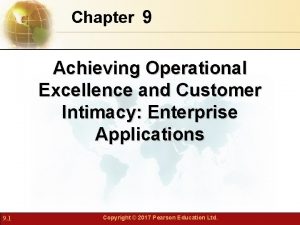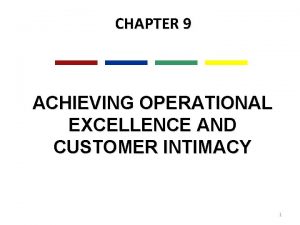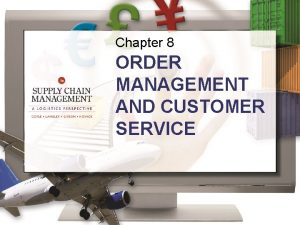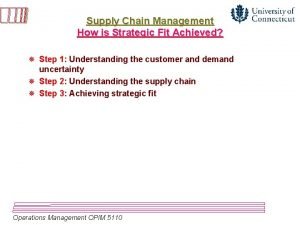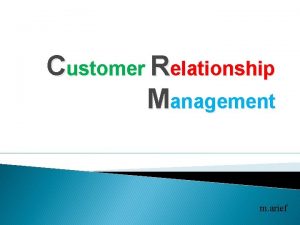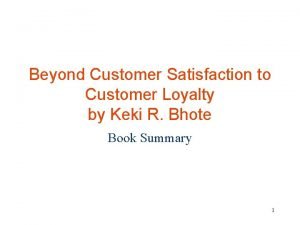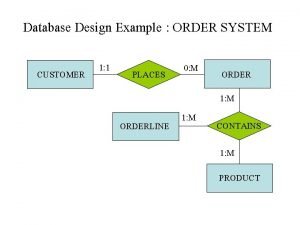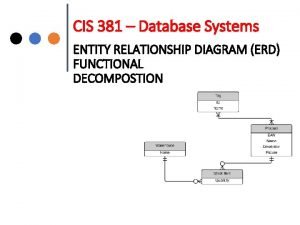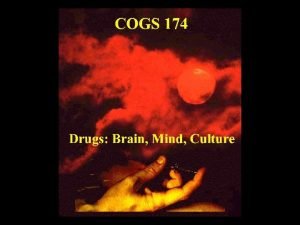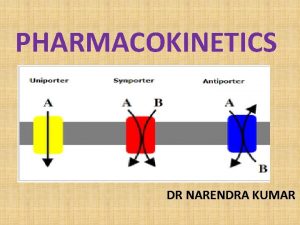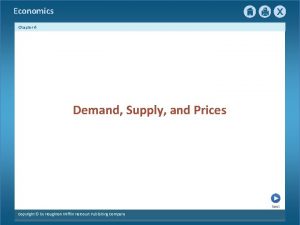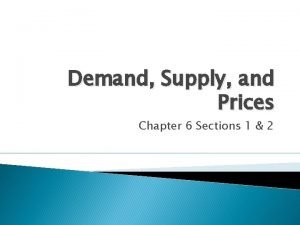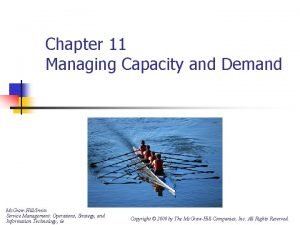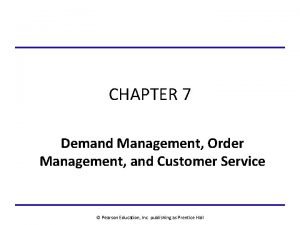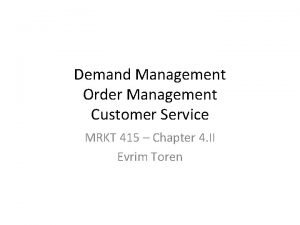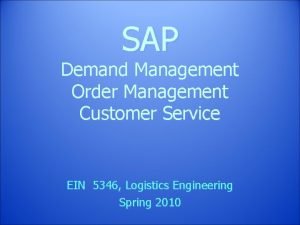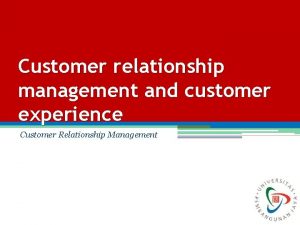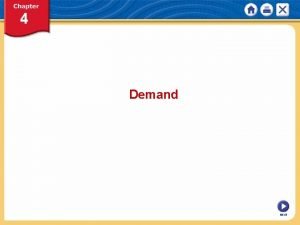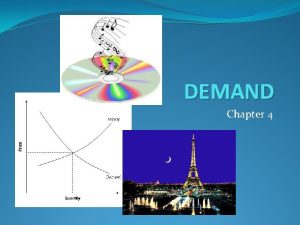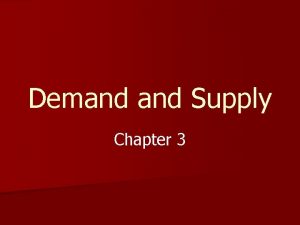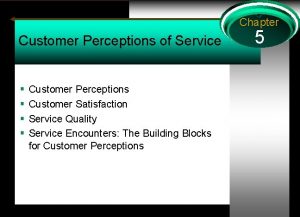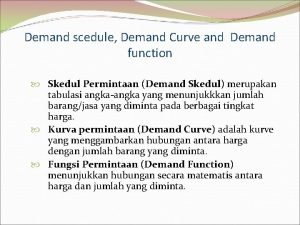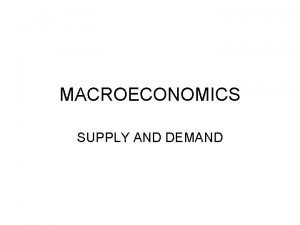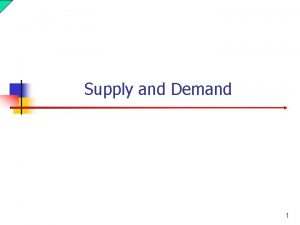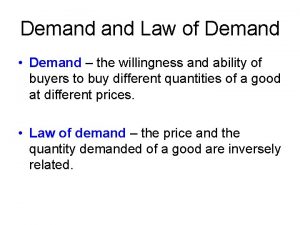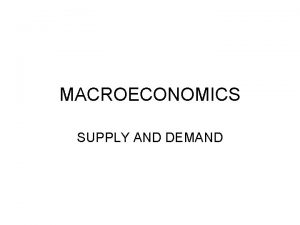CHAPTER 7 Demand Management Order Management and Customer

































- Slides: 33

CHAPTER 7 Demand Management, Order Management, and Customer Service

Learning Objectives • To understand the linkages between demand management, order management, and customer service • To introduce you to demand forecasting models Models + • To examine the order cycle and its four company system = components DSI 7 -2

Learning Objectives • To understand the four dimensions of customer service as they pertain to logistics • To familiarize you with select managerial issues associated with customer service 7 -3

Order Management and Customer Service Key Terms • Activity-based costing • Benchmarking • Cause-and-effect (associative) forecasting • Collaborative planning, forecasting, and replenishment (CPFR) • Customer profitability analysis (CPA) • Customer service • Demand management • Judgmental forecasting • Make-to-order • Make-to-stock • Multichannel marketing systems • Order cycle 7 -4

Order Management and Customer Service Key Terms Order delivery Order fill rate Order management Order picking and assembly • Order processing • Order to cash cycle • Order transmittal • • • Order triage • Pick-to-light technology • Service recovery • Time series forecasting • Voice-based order picking 7 -5

Demand Management • Demand management can be defined as “the creation across the supply chain and its markets of a coordinated flow of demand. ” Within the company = DSI – Demand Supply Integration 7 -6

Demand Management • Demand (sales) forecasting – Refers to an effort to project future demand – Is a key component in demand management – Is helpful in make-to-stock situations – Is helpful in make-to-order situations Non-determined demand Determined demand (or combination – tyre production – production for car producer and production for service market) 7 -7

Demand Management • Three basic types of demand forecasting models: – Judgemental – Time series – Cause and effect (associative) quantitative and qualitative methods 7 -8

Demand Management • Judgmental demand forecasting model: – Involves using judgment or intuition – Preferred in situations where there is limited or no historical data – Techniques include surveys, the analog technique, and others • Surveys used to learn about customer preferences and intentions • An analog (similar item to that being forecasted) is used as the basis for demand history 7 -9

Demand Management • Time series forecasting model: – Underlying assumption is that future demand is solely dependent on past demand – Some techniques include: • Simple moving averages • Weighted moving averages 7 -10

Demand Management 7 -11

Demand Management • Cause-and-effect forecasting model: – Also referred to as associative forecasting – Assumes that one or more factors are related to demand that the relationship between cause and effect can be used to estimate future demand – Some techniques include: • Simple regression • Multiple regression 7 -12

Demand Management • Demand forecasting issues: – Selection of forecasting technique(s) depends on many factors – Selecting an inappropriate technique will reduce forecast accuracy – Forecast accuracy can have important logistical implications – Computer forecasting software unable to completely eliminate forecast errors 7 -13

Order Management • Order management refers to management of the various activities associated with the order cycle • Order cycle (replenishment cycle or lead time) refers to the time from when a customer places an order to when goods are received • Some organizations include order to cash cycle in their order management model 7 -14

Order Management • Four stages of the order cycle include: – Order transmittal – Order processing – Order picking and assembly – Order delivery 7 -15

Order Management • Order transmittal refers to the time from when the customer places an order until the seller receives the order • Methods of order transmittal • In person ? • Mail • Telephone ? • FAX • Electronically 7 -16

Order Management • Order processing refers to the time from when the seller receives an order until an appropriate location (i. e. warehouse) is authorized to fill the order INCOTERMS 2000 – international commercial terms 7 -17

Order Management • Order processing includes: – Checking for completeness and accuracy Critical – A customer credit check – Order entry into the computer system commercial decision – Crediting salesperson with the sale – Recording the transaction – Determining inventory location – Arranging for outbound transportation 7 -18

Figure 7. 1: Flowchart of Order Handling (Order Processing) System 7 -19

Order Management • Order picking and assembly includes all activities from when an appropriate location is authorized to fill the order until goods are loaded aboard an outbound carrier Filling the order = invoicing 7 -20

Order Management • Order picking and assembly – Often represents the best opportunity to improve the effectiveness and efficiency of an order cycle – Can account for up to 2/3 of a facility’s operating cost and time …. . ? 7 -21

Order Management • Examples of Order Picking and Assembly technology: – Handheld scanners – Radio-frequency identification (RFID) – Voice-based order picking https: //www. youtube. com/watch? v=77 Do. Ld. Qv. XNQ – Pick-to-light: https: //www. youtube. com/watch? v=t. PIQp. Ki_-Ko 7 -22

Order Management • Order delivery is the time from when a transportation carrier picks up the shipment until it is received by the customer. 7 -23

Customer Service • Customer service is “the ability of logistics management to satisfy users in terms of time, dependability, communication , and convenience. ” • Customer service is much more difficult for competitors to imitate than other marketing mix variables such as price and promotion 7 -24

Customer Service • Four dimensions of customer service include: – Time § Refers to the period between successive events (example - order cycle) – Dependability § refers to the reliability of the service encounter § consists of three elements: consistent order cycles, safe delivery, and complete delivery – Communication – Convenience 7 -25

Customer Service • Four dimensions of customer service include: – Communication § If effective should be a two-way exchange between seller and customer § Goal is to keep both parties informed § Requires correct parties to be involved in the process – Convenience § Focuses on the ease of doing business with a seller 7 -26

Managing Customer Service • Four specific customer service considerations include: – Establishing customer service objectives – Measuring customer service – Customer profitability analysis (CPA) – Service failure and recovery 7 -27

Managing Customer Service • Measuring Customer Service – “you can’t manage what you can’t measure” – Key issues include: § Determining data sources to be used § Determining what factors to measure § Organizations must resist excessive measurement 7 -28

Managing Customer Service 7 -29

Managing Customer Service • Customer Profitability Analysis (CPA) is the allocation of revenues and costs to customer segments or individual customers to calculate the profitability of the segments or customers 7 -30

Managing Customer Service • Customer Profitability Analysis (CPA) – Suggests that different customers consume differing amounts and types of resources – Recognizes that all customers are not the same and some customers are more valuable than others to an organization Customer Life-time Value – Can help to identify when an organization should pursue different logistical approaches for different customer groups – Has been facilitated by the acceptance of activitybased costing 7 -31

Managing Customer Service • Service Failure and Service Recovery – Situations will occur where actual performance does not meet the customer’s expected performance (i. e. service failure) – Service failure is relevant to the order cycle – Examples of order-related service failures include: • • • Lost delivery Late delivery Early delivery Damaged delivery Incorrect delivery quantity 7 -32

Managing Customer Service • Service Failure and Recovery – Service recovery § Process for returning a customer to a state of satisfaction after a service or product has failed to live up to expectations § Is often costly § May lead to increases customer loyalty § Can result in better performing organization by learning from failure and implementing processes and policies to prevent reoccurrence 7 -33
 Customer relationship management and customer intimacy
Customer relationship management and customer intimacy Customer relationship management and customer intimacy
Customer relationship management and customer intimacy Intimacy
Intimacy 1st order 2nd order 3rd order neurons
1st order 2nd order 3rd order neurons Module 5 supply and demand introduction and demand
Module 5 supply and demand introduction and demand Measures to correct deficient demand
Measures to correct deficient demand Dependent demand inventory example
Dependent demand inventory example Supply schedule halimbawa
Supply schedule halimbawa Demand estimation and demand forecasting
Demand estimation and demand forecasting Distinguish between individual demand and market demand
Distinguish between individual demand and market demand Inventory models for independent demand
Inventory models for independent demand Order management & customer service relationship concept
Order management & customer service relationship concept Deterministic demand vs stochastic demand
Deterministic demand vs stochastic demand Market demand curve
Market demand curve Independent vs dependent demand
Independent vs dependent demand Strategic fit supply chain
Strategic fit supply chain Using marketing information to gain customer insights
Using marketing information to gain customer insights Pengertian customer relation
Pengertian customer relation Beyond customer satisfaction to customer loyalty
Beyond customer satisfaction to customer loyalty Demand management and capacity management
Demand management and capacity management Customer order database design
Customer order database design Business rules for erd
Business rules for erd Natural order of sentence examples
Natural order of sentence examples Difference between 1st order and zero order kinetics
Difference between 1st order and zero order kinetics Metaboloism
Metaboloism First and second order change
First and second order change Law is order and good law is good order
Law is order and good law is good order First order cybernetics and second order cybernetics
First order cybernetics and second order cybernetics Crm and scm
Crm and scm 5 determinants of supply
5 determinants of supply Chapter 6 section 2 supply and demand in everyday life
Chapter 6 section 2 supply and demand in everyday life Sras lras
Sras lras Chapter 6 demand supply and prices
Chapter 6 demand supply and prices Managing capacity and demand
Managing capacity and demand

